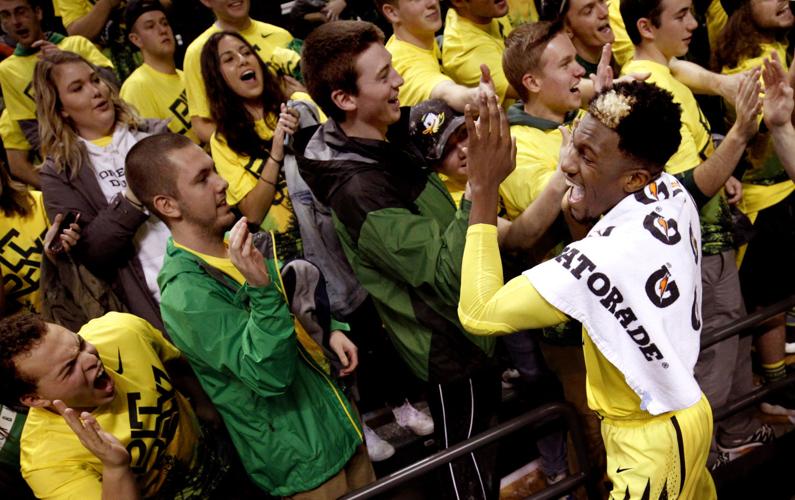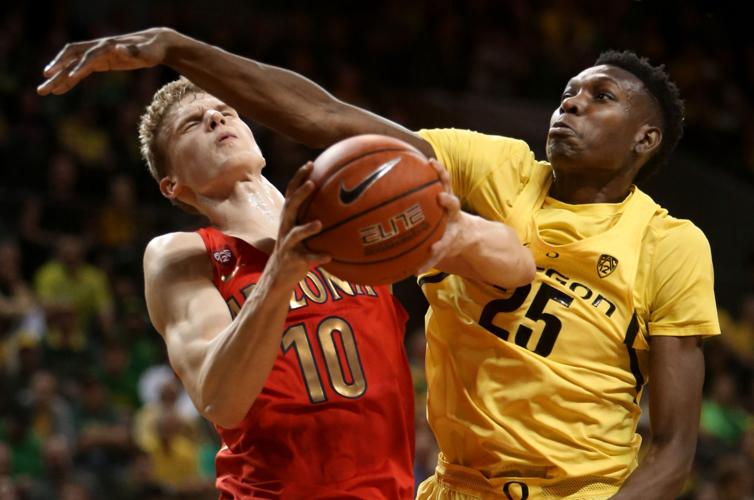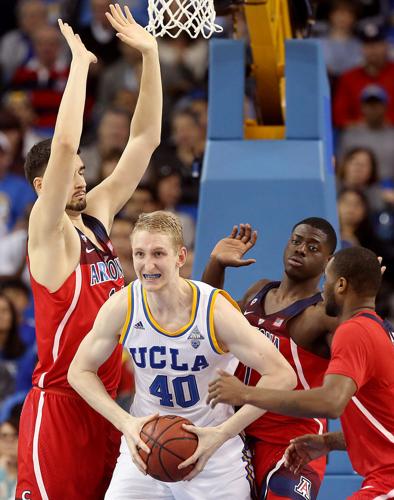For the first time in its long history, Pac-12 basketball has become the Big Three — imposing power at the top — a season so rare it makes you wonder if the excellence at Oregon, Arizona and UCLA is sustainable.
The three teams went a combined 47-7 in conference games this season, which is unprecedented since the Pac-10 was forged in 1978-79.
Even those classic Arizona vs. Stanford years of 1998-2005 couldn’t generate a better threesome than 45-9.
This is the most formidable leaderboard in league history.
In 1992, Arizona, UCLA and USC finished the season in the AP Top 10, yet their cumulative league record was 44-10.
It can’t match what the Wildcats, Ducks and Bruins did this season.
Basketball in the Pac-12 has never produced a so-called Golden Era, unless you go back to the John Wooden years at UCLA. But that wasn’t a Golden Era at all. The Bruins bullied their competition so thoroughly that in a 10-year period from 1964-73 they won conference championships by an average of 3.8 games per season.
Is this the future of Pac-12 hoops? Could this at last be a power trio of UCLA, Arizona and Oregon that can rival the ACC’s Duke, North Carolina and Louisville on the national stage, vying for ESPN ratings and prime-time attention?
All seem built for basketball’s long haul.
Oregon coach Dana Altman is 58. Why would he leave the Ducks now? After growing up in Nebraska, he coached 16 seasons at Creighton, his home turf. He will never get a better job than he has at Nike U., which now swings for the fences in the top-100 recruiting battles.
Sean Miller is 48. He reestablished Arizona as a Top 10 program after the messy Lute Olson transition years. Maybe he’s not a lifer at Arizona, maybe Ohio State or Louisville will someday buy him out of his Arizona contract, but much like the football program at Ohio State, which has survived five coaching changes since the Woody Hayes days, Arizona basketball is an established brand.
UCLA coach Steve Alford is 52. Unless his alma mater Indiana can turn his head at some point, Alford has no better option than Pauley Pavilion. And even if he loses control of a wealth of recruiting talent and spins out, as did his predecessor Ben Howland, the Bruins will be able to find a superior replacement.
Until now, the Pac-12’s most successful group of three was the 1981 coupling of Oregon State, Arizona State and UCLA. They finished 46-8, a winning percentage that lasted until now.
Oregon State went 17-1 and was ranked No. 1 much of the year. ASU was 16-2 and finished the season No. 3 in the AP poll. UCLA, coming off a Final Four appearance, went 13-5.
But the Pac-10 of 1981 (and companion years) was dreadful. Stanford and Cal weren’t much better than campus intramural all-star teams, stuck in dingy, mostly-empty gymnasiums. Arizona was going through a five-year implosion. Oregon didn’t have two good players to put together.
With little competition, the Beavers, Sun Devils and Bruins looked to be national powers into the foreseeable future.
But then it all came apart with an unexpected fury.
Stunningly, all lost first-round games in the 1981 NCAA Tournament and it was never the same at the schools.
UCLA coach Larry Brown bolted from to Kansas at year’s end, and UCLA’s administration made two consecutive coaching blunders, hiring Larry Farmer and Walt Hazzard.
ASU similarly dissolved as a basketball power, firing the best coach in school history, Ned Wulk a year later. The Sun Devils have since won five NCAA games, or roughly one per seven years.
Oregon State coach Ralph Miller was 62 when the Beavers fell as a top-seed in the 1981 tournament. His best years were gone. OSU has not won a game in the NCAA tournament since 1982.
The future of Pac-12 basketball, while never secure, has rarely been more promising.
The school most likely to challenge the Oregon/UCLA/Arizona freight train is Utah. The Utes rose above a middlin’ middle class to get the league’s No. 4 seed in the Pac-12 tournament. The Utes drew an average of 12,519 fans and, after UCLA and Arizona, have the third most treasured history of Pac-12 teams.
Plus, Utah coach Larry Krystkowiak, 52, who has five children and has done his time on the NBA circuit, appears ready to dig in in Salt Lake City. He has enough coaching chops to make it a Big Four someday.
It’s unlikely Colorado’s Tad Boyle and Stanford’s Jerod Haase can consistently recruit at a level high enough to come close to duplicating what Mike Montgomery built at Stanford from 1988-2004.
After that it’s a cluster of wannabees. Washington sits on a mother lode of Seattle AAU talent, and has created a loyal following in the Lorenzo Romar years, but it is clearly a troubled program. Cal? It can’t get over the hump. USC? We’ve seen this building-for-greatness act before. ASU? Patience is required.
The Pac-12 needs a Big Three.
The league averaged 7,991 fans per home game this year, which is the top figure in Larry Scott’s years as commissioner, but interest seems to have dropped, not grown.
The league averaged more than 8,000 fans six times from 2000-08, and then weathered a dark period in which even the 2012 league champion, Washington, was not invited to the NCAA Tournament.
There’s no danger of that now. The Big Three has sent an easy-to-read message to the rest of the league: You must step it up to keep up.






